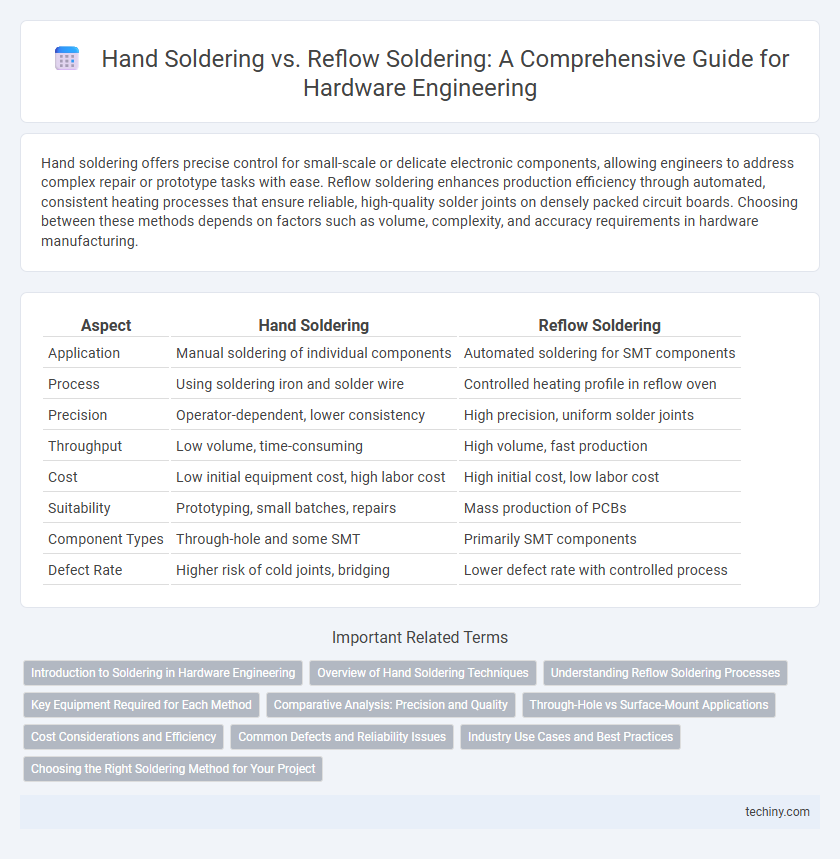Hand soldering offers precise control for small-scale or delicate electronic components, allowing engineers to address complex repair or prototype tasks with ease. Reflow soldering enhances production efficiency through automated, consistent heating processes that ensure reliable, high-quality solder joints on densely packed circuit boards. Choosing between these methods depends on factors such as volume, complexity, and accuracy requirements in hardware manufacturing.
Table of Comparison
| Aspect | Hand Soldering | Reflow Soldering |
|---|---|---|
| Application | Manual soldering of individual components | Automated soldering for SMT components |
| Process | Using soldering iron and solder wire | Controlled heating profile in reflow oven |
| Precision | Operator-dependent, lower consistency | High precision, uniform solder joints |
| Throughput | Low volume, time-consuming | High volume, fast production |
| Cost | Low initial equipment cost, high labor cost | High initial cost, low labor cost |
| Suitability | Prototyping, small batches, repairs | Mass production of PCBs |
| Component Types | Through-hole and some SMT | Primarily SMT components |
| Defect Rate | Higher risk of cold joints, bridging | Lower defect rate with controlled process |
Introduction to Soldering in Hardware Engineering
Hand soldering offers precise control for small-scale or repair tasks, making it ideal for prototypes and delicate components in hardware engineering. Reflow soldering automates the process by heating solder paste on printed circuit boards (PCBs) to achieve consistent, high-quality solder joints, enabling efficient mass production. Both techniques are fundamental for assembling and repairing electronic devices, with hand soldering suited for intricate operations and reflow soldering optimized for speed and uniformity.
Overview of Hand Soldering Techniques
Hand soldering techniques involve manually applying solder to electronic components using a soldering iron, which allows for precise control in small-scale or repair tasks. Common methods include drag soldering, point-to-point soldering, and through-hole soldering, each suited for different PCB assembly needs. Mastery of temperature control, solder wire selection, and proper tip maintenance is essential to ensure reliable electrical connections and prevent thermal damage to sensitive components.
Understanding Reflow Soldering Processes
Reflow soldering involves applying solder paste to PCB pads, placing components, and heating the assembly to a precise temperature profile to melt the solder and create reliable joints. This process offers consistent solder quality and is ideal for surface mount technology (SMT) components, contrasting with hand soldering's manual application and variability. Key parameters include temperature ramp rate, peak temperature, and cooling rate, all critical for minimizing thermal stress and ensuring optimal solder joint integrity.
Key Equipment Required for Each Method
Hand soldering requires essential equipment such as a soldering iron, solder wire, flux, tweezers, and a magnifying glass to ensure precision in manual component placement and connection. Reflow soldering demands a reflow oven or infrared heater, solder paste, stencil printers for accurate paste application, and conveyor systems for effective thermal profiling and automated processing. Both methods rely on temperature-controlled tools but differ significantly in automation and throughput capabilities.
Comparative Analysis: Precision and Quality
Hand soldering offers greater control for delicate tasks requiring precise placement, enabling engineers to address individual component needs accurately. Reflow soldering provides consistent thermal profiles that enhance joint reliability and reduce defects across large batches, ensuring uniform quality. While hand soldering excels in customized, low-volume applications, reflow soldering is ideal for mass production with stringent quality control standards.
Through-Hole vs Surface-Mount Applications
Hand soldering excels in through-hole applications by allowing precise manual control to securely attach components with leads passing through PCB holes, ideal for prototypes or repairs. Reflow soldering is optimized for surface-mount technology (SMT), using controlled heat profiles to rapidly melt solder paste and form high-quality joints on densely packed surface-mount pads. Through-hole components often benefit from mechanical strength via hand soldering, while surface-mount devices gain from the scalability and consistency of reflow processes in mass production.
Cost Considerations and Efficiency
Hand soldering involves lower initial equipment costs but requires skilled labor, leading to higher per-unit labor expenses and longer production times. Reflow soldering demands significant upfront investment in ovens and temperature control systems but offers rapid, consistent solder joint formation ideal for high-volume manufacturing. Balancing cost considerations, reflow soldering provides superior efficiency and scalability despite a higher initial capital outlay.
Common Defects and Reliability Issues
Hand soldering often results in common defects such as cold joints, insufficient wetting, and bridging due to manual inconsistency and operator skill variability. Reflow soldering presents challenges like tombstoning, solder balling, and voids, primarily caused by improper temperature profiles and flux residues. Reliability issues in hand soldering include mechanical weakness and intermittent connections, whereas reflow soldering can suffer from thermal stresses impacting long-term component performance.
Industry Use Cases and Best Practices
Hand soldering excels in precision tasks and prototyping where manual control is critical, commonly used in repair work and small-scale production. Reflow soldering dominates mass manufacturing of surface-mount devices, providing consistent quality and efficiency for high-volume PCB assembly. Best practices involve using temperature-controlled soldering irons for hand soldering to prevent component damage, while reflow processes require optimized temperature profiles and solder paste formulations to ensure reliable joint formation.
Choosing the Right Soldering Method for Your Project
Hand soldering offers precision and control for small-scale or repair projects, ideal for prototyping and complex component placements. Reflow soldering excels in mass production, ensuring consistent heating and strong joints through automated temperature profiles for surface-mount technology (SMT) components. Selecting the right method depends on project scale, component types, and desired production efficiency to optimize solder joint reliability and assembly quality.
Hand soldering vs Reflow soldering Infographic

 techiny.com
techiny.com